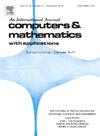结构网格上五阶 MR-WENO 方案的具有最佳充分 CFL 数的纯正性保留方法
IF 2.9
2区 数学
Q1 MATHEMATICS, APPLIED
引用次数: 0
摘要
本文针对五阶有限体积多分辨率 WENO(MR-WENO)方案提出了一维和二维纯正性保留(PPP)方法,以解决结构网格上的一些极端问题。MR-WENO 空间重建程序只需要一个五单元、一个三单元和一个一单元模板,就能在光滑区域实现统一的五阶精度,并在一维非光滑区域保持基本的非振荡特性。在进行这样的空间重构后,我们重新定义了五个新的单元平均向量,并在此基础上设计了一个四元多项式向量和三个二次多项式向量。然后,使用新的检测程序来检查整个目标细胞内三个二次多项式向量的密度和压力是否为正值。如果出现负值,则执行新的压缩限制器,使整个目标单元内的三个二次多项式向量的密度和压力为正值,目标单元中点的一个四次多项式向量的密度和压力为正值。由于现在可以获得精确的密度和压力最小值,因此这是一种设计保正值方法的新方法,以保持五阶精度和整个目标池的正值性,而不是只在某些离散的高斯-洛巴托二次点上保持正值性。然后给出了理论证明,将五阶 WENO 方案的最佳充分 CFL 数从 1/12 增加到 1/6。这种方法可以很容易地扩展到多维度。与一些经典的正性保留方法不同,PPP 方法可以应用特殊的四点高斯-洛巴托正交公式或任何其他正交公式,条件是其数值精度不小于四。由于 1/6 的最佳 CFL 数是一个充分但非必要的条件,因此五阶有限体积 MR-WENO 方案的新颖 PPP 方法也可以使用更大的实用 CFL 数(0.6),并且在模拟一些极端问题时具有足够的鲁棒性,而无需及时将其减半。本文章由计算机程序翻译,如有差异,请以英文原文为准。
Pure-positivity-preserving methods with an optimal sufficient CFL number for fifth-order MR-WENO schemes on structured meshes
In this paper, one-dimensional and two-dimensional pure-positivity-preserving (PPP) methods are proposed for fifth-order finite volume multi-resolution WENO (MR-WENO) schemes to solve some extreme problems on structured meshes. The MR-WENO spatial reconstruction procedures only require one five-cell, one three-cell, and one one-cell stencils for achieving uniform fifth-order accuracy in smooth regions and keeping essentially non-oscillatory property in non-smooth regions in one dimension. One redefines five new cell averages vectors after performing such spatial reconstructions and design one quartic polynomials vector and three quadratic polynomials vectors based on them. After that, a new detective process is used to examine the positivity of density and pressure of three quadratic polynomials vectors inside the whole target cell. If the negativity happens, a new compression limiter is carried out to enable the positivity of density and pressure of three quadratic polynomials vectors over the whole target cell and the positivity of density and pressure of one quartic polynomials vector at the midpoint of the target cell. It is a new way to design the positivity-preserving methods to keep fifth-order accuracy and the positivity over the target cell instead of only at some discrete Gauss-Lobatto quadrature points, since the precise minimum values of the density and pressure are now available. Then a theoretically proof is given to increase the optimal sufficient CFL number from 1/12 to 1/6 for the fifth-order WENO schemes. This methodology can be expanded to multi-dimensions easily. Unlike some classical positivity-preserving methods, the PPP methods could apply a special four-point Gauss-Lobatto quadrature formula or any other quadrature formulas on condition that their numerical precision is no smaller than four. Since the optimal CFL number of 1/6 is a sufficient but not necessary condition, the novelty PPP methods for fifth-order finite volume MR-WENO schemes with a larger practical CFL number of 0.6 are also available and robust enough when simulating some extreme problems without timely halving its value.
求助全文
通过发布文献求助,成功后即可免费获取论文全文。
去求助
来源期刊

Computers & Mathematics with Applications
工程技术-计算机:跨学科应用
CiteScore
5.10
自引率
10.30%
发文量
396
审稿时长
9.9 weeks
期刊介绍:
Computers & Mathematics with Applications provides a medium of exchange for those engaged in fields contributing to building successful simulations for science and engineering using Partial Differential Equations (PDEs).
 求助内容:
求助内容: 应助结果提醒方式:
应助结果提醒方式:


